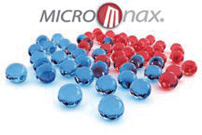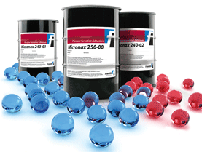|  New Micronax Microsphere Line Offers Maximum Repositionability New Micronax Microsphere Line Offers Maximum Repositionability
How can a new technology that begins with the prefix “micro” constitute such big news for customers of Franklin Adhesives & Polymers?
It does because the news is that we have launched Micronax® Microsphere adhesives – easily, our most repositionable PSA.
Microsphere technology provides the highest degree of repositionability of any type of PSA available. The big difference between microspheres and conventional emulsion adhesives is the size of the particles: The larger particles, or spheres, used in microsphere adhesives create a discontinuous adhesive surface that limits physical contact with a substrate and makes it ultra-removable and permanently repositionable. Conversely, smaller particles used in conventional emulsion adhesives combine into a continuous film that typically prohibits removal of labels without damage to the labels or the surface to which they’re applied.
The development of Micronax microsphere adhesives opens up new possibilities for adhesion to our customers in a broad array of industries. You can use them for applications ranging from product decorations, wall graphics, temporary signage and repositionable notes to arts and crafts and advertising pieces. They also have been approved for FDA indirect food contact; and can be screen-printed without adversely affecting adhesive performance.
To serve as many of our customers as possible, we have developed two lines of Micronax microsphere adhesives: the 240 and 250 series. Together, these series meet most typical applications requiring ultra-repositionable adhesives. Both PSA series are acrylic-based and available in a broad range of viscosities, with performance properties tailored to your specific needs. The 250 Series offers a much higher solids content for reduced drying time when applied and higher productivity.
If existing formulations do not meet your needs exactly, we can customize the ideal microsphere adhesive for you. Our team can modify sphere sizes from 20 to 80 microns, and you can easily dial in performance characteristics for a specific application.
As your adhesives partner, we at Franklin Adhesives & Polymers are here to help you find the right solution – whether that be the ideal Micronax Microsphere adhesive or a permanent or removable PSA from our Covinax and Acrynax product families. |
|
 Tips For Top Microsphere Performance Tips For Top Microsphere Performance
Here are a few tips to help you handle and apply Micronax Microsphere adhesives to deliver the best effect. For additional guidance, don’t hesitate to contact our technical service team at 1.800.877.4583 or e-mail us at marketing@franklininternational.com. Know Your Microspheres
• Microspheres are shear-sensitive. Avoid the destabilizing forces of high-shear pumping, filtering, high-speed mixing and coating methods. Small pumps operating at slow speeds and gentle mixing work best.
• Microspheres tend to rise to the top of their container. Gently stir microspheres before each use or transfer.
• Microspheres are pH sensitive. At no point should the pH be allowed to drop below 7.9.0; a lower pH will cause coagulum. A pH of 7.9 – 9.5 is recommended. If needed, adjust pH with 21% aqueous ammonia.
• Coagulated microspheres are unrecoverable. Discard any microsphere product that appears gelatinous.
The Story on Storage
• Temperatures of 50 – 90°F.
• Do not freeze.
• Shelf life: three to six months – most products will be okay for longer periods. Contact our technical service team for disposition and recommendations.
• Use partial drums that have been used in the coating process promptly; these tend to lose stability on standing.
Get the Jump On Pumping and Filtration
• Air creates foam; keep the pump inlet below the liquid level to prevent drawing both air and liquid into the pump.
• Do not use felt filter bags.
• Fine filtration removes spheres. Do not use filters finer than 60 mesh or finer than 250 microns.
• Pressure creates shear. Change filter bags when pressure exceeds 30 psi.
How to Handle Before and During Coating
• Keep the pH between 7.9 and 9.5.
• Add all formulating ingredients slowly under agitation. Agitation should be at a speed that generates a vortex but does not generate splashing and/or foam.
• Defoamer can be added to minimize foam in coating operation, typically 0.1 to 0.2 percent if oil/silicone based and 0.1 percent if silicone-based. Pre-mix defoamer 1:1 with water.
• Avoid free-fall of adhesive during recirculation process; laminar flow is recommended during coating operation.
• Micronax products can be rod, roll (e.g. gravure) or slot-die coated. |
|
More on Micronax
Franklin Adhesives & Polymers has developed a complete kit of information on Micronax Microsphere Adhesives. We will be happy to mail you your free kit upon request. Please e-mail us at marketing@franklininternational.com; or call Abbe Raabe, marketing communications manager, at 614.445.1337. |